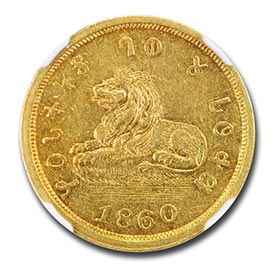
Mormon Utah Gold (1849-1860)
Territorial and private issues were common all the way through the Coinage Acts of 1857 and 1864, which banned private and foreign money from circulating alongside U.S.-minted currency. There were still private issues that circulated in Western states and territories like Utah and California even after this act. Some of these were certified by the U.S. government before official mints were put in place, while others only saw circulation for a limited period of time. Utah saw some private issues created when it was called the Mormon Territory. These were struck at the behest of the Church of Jesus Christ of Latter-Day Saints, with Brigham Young personally supervising the mint.
Mormon Utah Gold Design
The history of early United States coins embraces a wide variety of money, not just coins minted within the United States itself. World coins saw common usage across the whole of the United States, and major denominations from countries like the Netherlands, France, and Spain were widely circulated through the 1850s. British coins were commonplace, not surprising considering the American colonies were under British rule. The bulk of coinage was English crowns, shilling and pence as well as the Spanish piece of eight (which laid the groundwork for the Silver dollar). This began to change as the U.S. started striking its own coins, but this currency still circulated alongside it.
Foreign coins were not the only circulating currency in the New World. Private issues were also available, and there were circulating coins created by some of the states in both colonial and post-colonial times. There are several major privacy issues that were created in the Americas and saw varying degrees of circulation. After the colonial era, many of these were Gold coins created to fill in the gaps in higher-denomination coinage. Gold private and regional issues saw use even after they technically became illegal, particularly out in the Western states.
“Private Gold” is defined by the Guide Book of United States Coins as “interesting necessity pieces of various shapes, denominations and degrees of intrinsic worth that were circulated in isolated areas of the United States by individuals, assayers, bankers and so on”.
Some issues were allowed under U.S. law. Provisional mints were established as private enterprises out in California and other new Western states. Out in the West and the territories, Precious Metals saw more circulation than they did back East. Eastern states were moving towards banknotes and base metal coins were starting to gain traction, but in the farther-flung areas, there were not the same established networks of value. That meant people gravitated to the things that they knew held value regardless: Gold and Silver.
Sutter’s Mill was the site of the first discovery of Gold in California. Members of the Mormon Battalion who had fought in the Mexican-American War settled around there and were working for foreman James Marshall at the time. They helped Marshall with his Gold strike in 1848, and a couple of months later they created and settled their own mining town called Mormon Island. Gold was found in this area as well and it was sent back to Utah.
The Church of Jesus Christ of Latter-Day Saints ran the Mormon Territory, at the time called the “State of Deseret”. They saw a need for coins in their territory, and Brigham Young and high-ranking church officials John Taylor and John Kay personally created the dies and supervised the striking of new coins. Known examples are dated 1849, 1850 and 1860. Minting actually began in December 1848.
The first design of the $2.50, $5, $10 and $20 incorporated a Phrygian cap above an eye on the obverse and a set of clasped hands on the reverse. This design was used for all but the 1860 $5 coin, which had a lion on the obverse and a beehive (a common Mormon symbol) on the reverse.
Historical Significance
These coins were created at a unique time in American history. The Mormon $20 coin beat out the Double Eagle as the first $20 coin by about a year, making it an interesting historical precedent.
Numismatic Value
These coins are expensive even in low grades, with the lowest going for tens of thousands of dollars and the highest going for multiple hundreds of thousands of dollars. Only about 4,000 of these were made, and they were underweight due to the mint operators’ inexperience. Many of these were later melted down. Surviving examples is extremely rare.
Expand your collection today and shop our assortment of rare coins.

PCGS Products
You need the most up-to-date pricing on your coin collection. That’s why APMEX has partnered with PCGS, the premier grading authority in the world of rare coins, to bring you constantly updated pricing on collectibles and rarities. PCGS has been grading coins since 1986, bringing consistent standards of quality to a fractured industry. In the years since they have remained a source of reliable information on the current collectible and rare coin market.





